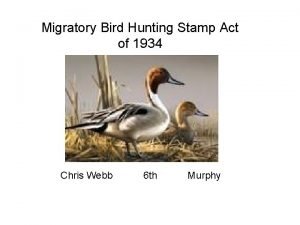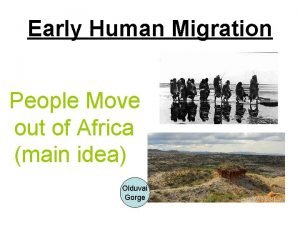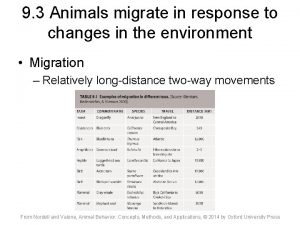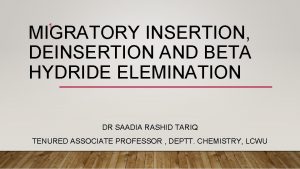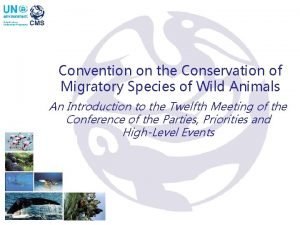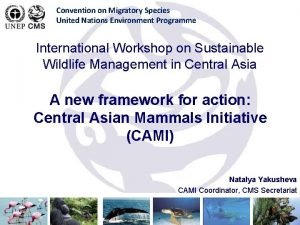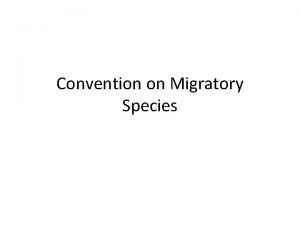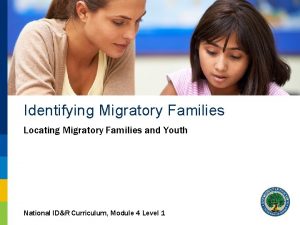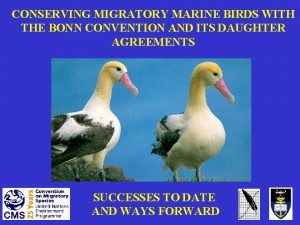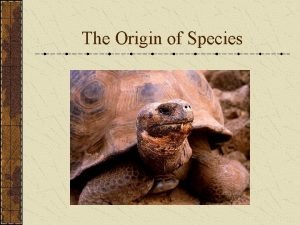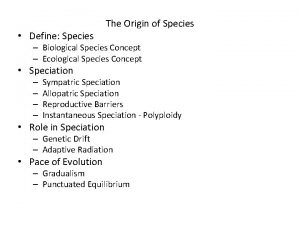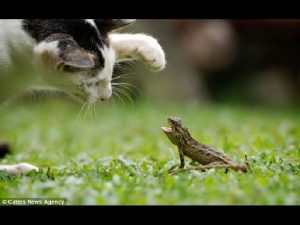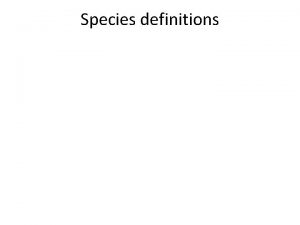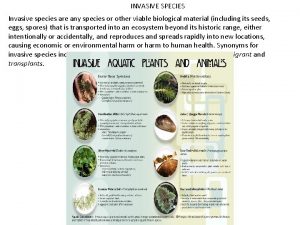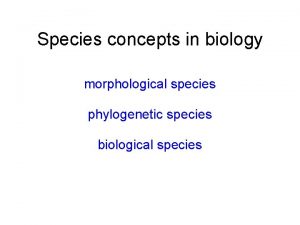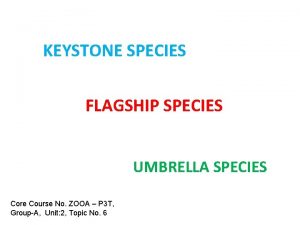Convention on the Conservation of Migratory Species of



















- Slides: 19

Convention on the Conservation of Migratory Species of Wild Animals An Introduction to the Twelfth Meeting of the Conference of the Parties, Priorities and High-Level Events

They run… Selected migratory ranges for ungulates

They fly… Selected migratory routes for birds

They swim… Migratory routes for selected marine species

What is CMS? A framework for countries to conserve migratory species throughout their entire range Definition An entire population or any geographically separate part of the population of any species, significant number of whose members cyclically and predictably cross one or more national jurisdictional boundaries. Appendix I Migratory species threatened with extinction Appendix II Migratory species whose conservation requires international cooperation

Map of Parties (124 as of 1 August 2016)

Twelfth Meeting of the Conference of the Parties Key facts → When: 23 – 28 October 2017 → Where: Manila, the Philippines → Theme: Sustainable Development and Migratory Species → Associated events: Standing Committee Meeting and High-Level Events on 22 October → Participation of UN Environment Goodwill Ambassadors

Official COP 12 webpage http: //www. cms. int/cop 12

High-Level Events Three High-Level Events will be held on 22 October: → A Leadership Dialogue Breakfast, chaired by Erik Solheim, on the CMS agenda and the main theme of the third session of the United Nations Environment Assembly (UNEA 3) “Pollution Free Planet”. It will result in a message to be conveyed from the COP to UNEA 3; → A High-Level Panel Discussion on the role of wildlife conservation in the attainment of the Sustainable Development Goals. The discussion will be facilitated by a leading international broadcast journalist and will result in a Declaration to be submitted to the Conference for endorsement; → An award ceremony under the Migratory Species Champion Programme aiming to recognize governments, organizations or individuals that provide long-term support for the implementation of specific initiatives.

Species proposals Common name MAMMALS Chimpanzee Four species of Lasiurus bats Southern Red Bat Eastern Red Bat Hoary Bat Southern Yellow Bat Lion Leopard Gobi Bear Caspian Seal African Wild Ass Przewalski’s Horse Indian Gazelle Giraffe Common name FISH Whale Shark Dusky Shark Blue Shark Angelshark Common Guitarfish White-spotted Wedgefish Proposed Amendment Inclusion in Appendix I & II Inclusion in Appendix II Inclusion in Appendix I & II Inclusion in Appendix II Proposed Amendment Inclusion in Appendix II Inclusion in Appendix I & II Inclusion in Appendix II Common name BIRDS Christmas Frigatebird Black Noddy Steppe Eagle Four Asian vulture species White-rumped Vulture Indian Vulture Slender-billed Vulture Red-headed Vulture Five sub-Saharan vulture species White-backed Vulture Cape Vulture Rüppell’s Vulture Hooded Vulture White-headed Vulture Lappet-faced Vulture Yellow Bunting Great Grey Shrike Lesser Grey Shrike Proposed Amendment Inclusion in Appendix II Inclusion in Appendix I Inclusion in Appendix I Inclusion in Appendix II Inclusion in Appendix II

Species proposals - highlights Appendix I Migratory species threatened with extinction Appendix II Migratory species whose conservation requires international cooperation Both Appendices

Preventing Poisoning – focus on Lead Background - Poisoning - One of the major threats to birds worldwide - CMS COP 11 adopted Guidelines to prevent risks associated to 5 poisons including lead - Dedicated global Working Group under CMS to facilitate concerted efforts - WG also tasked with addressing either poison types or geographical regions for implementation of guidelines - Phasing out of lead in ammunition and fishing weights still to be implemented Action Requested - Endorse establishment of a global Lead Task Force to bring together key players and promote actions to minimize use of lead in hunting ammunition, fishing weights as well as leaded paint, discarded lead and that emanating from industrial mining and smelting processes.

Marine Debris Background - 5. 25 trillion pieces of plastic debris in the ocean; - Micro-platics, now prevalent in all the world’s oceans, carry an additional risk: research has shown that toxins attach easily to plastics, which therefore concentrate contaminants - 640, 000 tonnes of ‘ghost gear’ - abandoned, lost or otherwise discarded fishing gear – currently in our ocean, accounting for about 10 per cent of the total plastic waste in the sea; - Marine debris can be harmful to humans and animals by causing direct injuries, damaging boat engines, destroying coral reefs, entangling animals or blocking their digestive systems Action Requested - Adopt Resolution to tackle the problem, including that of ‘ghost gear’ and micro-plastics.

Underwater Noise Background - Marine wildlife, particularly mammals and fish, depend on sound for all aspects of their life - The direct detrimental impacts of human-generated noise which these species can suffer are multiple and depend on the nature of noise - Noise has been shown to be deadly for at least some species of whales with evidence linking intense military sonars with fatal whale strandings. Reduced fish catch rates of 50 -80 per cent near seismic surveys have also been reported in some species affecting fishing activities and communities Action Requested - Adopt CMS Family Guidelines on Environmental Impact Assessments for Marine Noise-generating Activities which were developed following an extensive consultation process involving governments, organizations and private sector

Vultures Background - Vultures play a fundamental role in cleaning up animal carcasses and preventing the spread of disease. - Vultures are killed on an unprecedented scale across Africa, taken for use in traditional medicine and electrocuted on power lines. - Main threat is poisoning. Pesticides are used illegally as poison baits to kill carnivores as a means of protecting both livestock and humans. Unfortunately, vultures too are lured to these baits and become unintentional victims. Furthermore, in recent years, poachers have been intentionally targeting vultures using similar baiting techniques to hide their illicit activities – birds circling above a kill is often how wardens become aware of poaching. Action Requested - Adopt Multi-species action plan for the conservation of African Eurasian vultures. The plan covers the whole geographic ranges of 15 species of Old World vultures.

Conservation of African Lions & Carnivores Background - The Lion is Vulnerable at the global level (2015 IUCN Red List Assessment) - populations declined by 60% in Western, Central and Eastern Africa and increased by 12% in Southern Africa - Lion Range State meeting (May 2016) – First Joint Meeting of CMS and CITES - Possible listing on CMS Appendices at COP 12 followed by establishment of conservation plans and strategies, capacity building, public awareness and projects to promote lion conservation Action Requested - Adopt African Carnivores Initiative, joint with CITES and IUCN, to provide framework to coordinate conservation activities in the region and coherently address common issues - It would cover Wild Dog, Cheetah, Leopard and Lion (all listed under CITES apart from Wild Dog. Currently Wild Dog and Cheetah listed under CMS)

Review Process under CMS Background - COP 11 launched an intersessional process to explore possibilities for strengthening implementation of the Convention through the development of a review process and to report to COP 12. - A dedicated Working Group was tasked to (i) Discuss a comparative analysis of best practices of existing review mechanisms of MEAs, including pros, cons and costs involved and (ii) Prepare options for a CMS review process. Action Requested - Adopt one of the two proposed options: Zero option and review process option. - Two open questions for COP 12: who can trigger the process (only Parties? ) and who can review it (Standing Committee or dedicated body)

Towards COP 12 → Ensure highest countries representation; → Raise additional funding to support the participation of all delegates from countries eligible for funding; → Complete all documents by given deadline i. e. Resolutions and Decisions that do not include a scientific element by 24 July (90 days) and all remaining documents in all languages by 23 August (60 days)

VISIT TO KNOW US www. twitter. com/Bonn. Convention www. facebook. com/bonnconvention http: //www. cms. int/
 Migratory bird hunting and conservation stamp act
Migratory bird hunting and conservation stamp act Human origin map
Human origin map Music
Music Migratory behavior
Migratory behavior Migratory aptitude is greater for
Migratory aptitude is greater for A keystone
A keystone Thế nào là hệ số cao nhất
Thế nào là hệ số cao nhất Diễn thế sinh thái là
Diễn thế sinh thái là Vẽ hình chiếu vuông góc của vật thể sau
Vẽ hình chiếu vuông góc của vật thể sau Slidetodoc
Slidetodoc 101012 bằng
101012 bằng Lời thề hippocrates
Lời thề hippocrates Tư thế worm breton là gì
Tư thế worm breton là gì đại từ thay thế
đại từ thay thế Quá trình desamine hóa có thể tạo ra
Quá trình desamine hóa có thể tạo ra Công thức tính thế năng
Công thức tính thế năng Sự nuôi và dạy con của hổ
Sự nuôi và dạy con của hổ Thế nào là mạng điện lắp đặt kiểu nổi
Thế nào là mạng điện lắp đặt kiểu nổi Dot
Dot Bổ thể
Bổ thể
